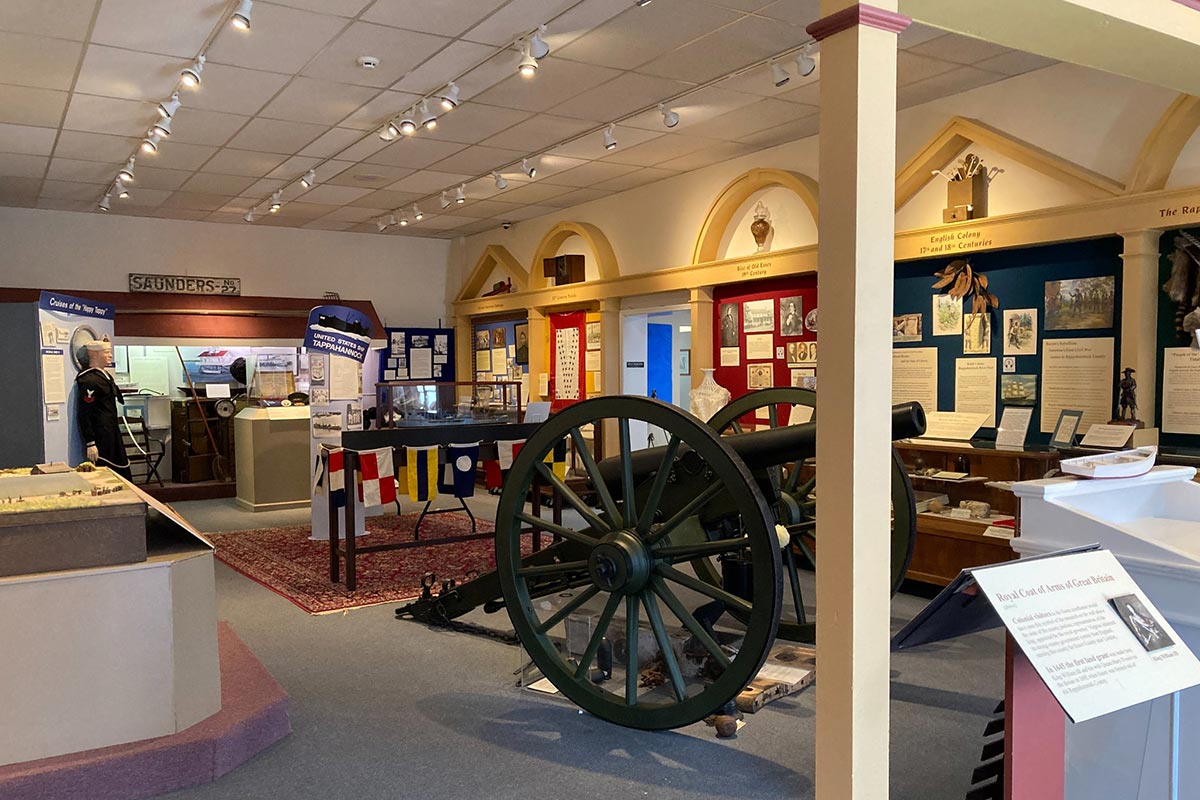Some Really Cool Stuff Happened in Essex County

Have fun while digging deep into history at the Essex County Museum and Historical Society
Think about this. Essex County history predates that of Colonial Williamsburg. Capt. John Smith, while exploring the Chesapeake Bay, visited Tappahannock in 1607 when it was a Rappahannock Indian village.
That makes the Essex County Museum, centered in a national historical district, a treasure trove. The Museum is located at 218 Water Lane in Tappahannock.
“Some really cool stuff happened in Essex County,” said Wright Andrews, serving his third year as the Museum’s President. “That’s something the local people can be proud of and the Museum should be a real tourist attraction. It’s far bigger than most county museums around us and certainly well worth visiting.”
What’s inside? Take a peek.
- The Museum houses artifacts spanning multiple centuries, including arrowheads left over from when the Rappahannock Indians were the region’s primary inhabitants, along with shark teeth and whale vertebrae from prehistoric times. Displays include items used by early settlers from Colonial times, and a cavalry saber and cannon from the Civil War era represent post-Colonial times. Not all the artifacts are ancient. A gym bag with melted shoes and a melted streetlight from last summer’s huge fire that burned down a block of historic Prince Street fire show what little was salvaged.
- Books, books and more books, many of them that you can’t find anywhere else,” said Tim Manley, the Museum’s Executive Director. One, “Uprooted and Transplanted from Africa to America,” by local author Lillian McGuire, documents the course of the African American experience in Essex County. Other publications explain how Essex citizens played key roles in helping craft Virginia’s first State Constitution and its early State government.
- The Museum will host a reading at 4 p.m. on Feb. 9th from a collection of love letters that were sent every Valentine’s Day from Thomas Lomax Hunter III, named Poet Laureate of Virginia by the General Assembly — to his wife, Marie during the years 1903 until his death in 1948. The poems, from a book titled “I, Ever Yours, and You, Forever Mine!” was published by longtime local resident Marty Glenn Taylor, who will read selections from the book.
- Research wedding dates and discover old maps and property records in the Museum’s Research Room. Staff can also help those exploring their genealogy find resources.
- An exhibit features the USS Tappahannock that served from World War II until Vietnam and received nine battle stars for each. A scale model of the 520-foot-long oiler, naval uniforms and artifacts tell the story of this ship that roamed the globe. Another exhibit has numerous artifacts from the Steamboat era.
- Touch the bars from an 1867 jailhouse. The bars are an actual window covering from the jail in Tappahannock. More touch points include a treasure chest from a pirate exhibit that appeals to youngsters and a replica of a traditional skiff.
- Correspondence and a slant top desk are part of a new exhibit on African American history.
- The official appointment of African American Robert H. Cauthorn to be Postmaster of Dunnsville from Sept. 21, 1897, is among the important documents in the Museum. The appointment is signed by the U.S. Postmaster General from that time.
- Find something to bring home from the Museum’s gift shop, where books are the best sellers along with locally sourced honey and peanuts. Postcards by local artists, oyster collectibles, magnets, ornaments, prints and more are among the unique gifts.
The Museum is preparing to announce a full slate of spring and summer programming, much of it outdoors in the recently completed Max Silver Memorial Courtyard, one of the more picturesque spots in town where benches and shade areas encourages visitors to linger.
Andrews is compiling a comprehensive timeline that starts before John Smith’s initial exploration of Tappahannock in 1607-08. During the English Civil War, many of the wealthy Cavaliers fled their home county and came to Essex County.
“You had people here with large plantations like Blandfield and Brooke’s Bank, but you also had plenty of the small folks who initially had rights for only 50 acres,” he said. “After the early wave of people, our agricultural area continued to grow with slaves replacing indentured servants. Most early citizens were ‘yeoman farmers,’ who eventually owned several hundred acres. After growing tobacco depleted the soil many of the old Essex families remained on their ‘plantations,’ which is what all farms were called. However, many others sought out richer unfarmed soils in unsettled areas elsewhere.”
Tappahannock was established in 1682.
“One of the amazing thing things about this county is we have so many families that are still here from Colonial days,” Andrews said. “We’ve got people who have very deep roots. A lot of them may go away for decades to have a business career, but then they come back and retire here, often on land that has been in their family for several hundred years. Essex County still has dozens of homes from Colonial and Early American times.”
Manley, his wife, Jess, and their two children recently put down roots in Tappahannock after moving from South Carolina. Manley is a College of Charleston graduate who organized and implemented several historical activities in that southern city, including an African carriage tour.
“The amount of ground covered in the Essex County museum is impressive,” Manley said. “We’ve got a little bit of everything from just about every time period. So, it really tells the whole story of Essex County. You don’t always get the full story when you’re in small town museums. But there are a lot of great stories to be told here. The museum does a good job of telling them.”
The Essex Museum and Historical Society is open from 10 a.m. until 3 p.m. on Tuesdays, Thursdays, Fridays and Saturdays.


